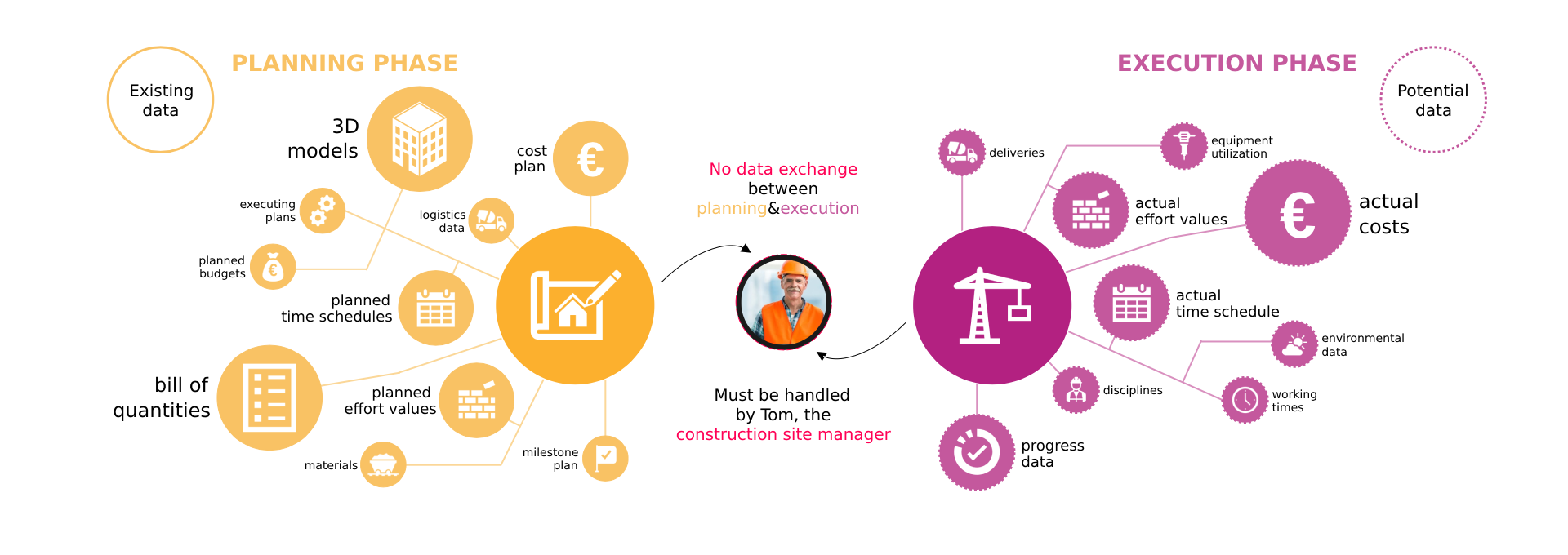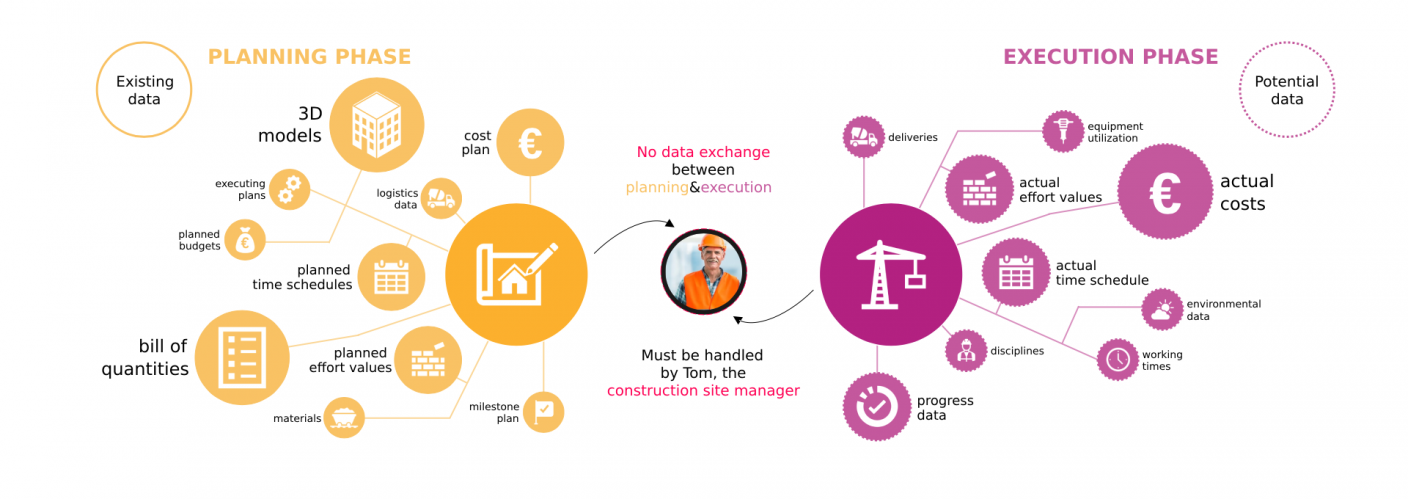In our previous blog post, we discussed about the different types of information in a construction project. Information is usually categorized according to the planning, design, pre-execution, execution, and operation stages which influences how it is created or used. The different stakeholders involved such as architects, engineers, contractors, suppliers, and owners, have their own unique workflows but are required to collaborate as the project evolves. This is why adequate access to data along with team collaboration are critical for a construction project to succeed [1].
Connected Construction Data:
Enabling an Integrated Information Ecosystem for Construction Projects.
Understanding Connected Construction
As we pointed out, an ‘integrated information hub’ such as a Common Data Environment (CDE) is inevitable to connect people, workflows, and data. You can imagine this as a ‘Dropbox’ for construction where the geometrical and non-geometrical data (BIM models, spreadsheets), and unstructured data (videos, pictures, text messages) is stored. Furthermore, a CDE serves as a prerequisite for maintaining a connected construction ecosystem. Deloitte defines connected construction as “an ecosystem of connected job sites, machines, and workers that enhances operational effectiveness and safety” to create the “smart, connected job sites of the future.” This is very important for tracking information flows to keep an eye on deviations between what has been planned and actual outcomes of the project. However, maintaining an integrated information ecosystem in construction remains a major challenge in an industry that is inherently complex with highly fragmented supply chains and a heavy reliance on manual processes. While the use of digital tools continues to grow, an incredible 95% of all data collected in the construction industry remains unused. We will explain why such a large amount of captured data is not being used and why the homogenization of construction data has the potential to solve this overarching problem [2].
The Construction Project: a breeding ground for ‘unconnected’ data?
A construction project is highly depended on data. This is because construction processes require individuals and teams to make decisions that are critical at every phase of the project lifecycle. As construction teams are seeking to reap the benefits of digitization, ensuring that data is adequately transferred between the planning and execution phases of a construction project is the necessary step to meet such goals. Projects struggle to reach this goal due to the lack of connected data workflows in the industry. This is most obvious as we move from the planning to execution phase.

Before the building works begin on site, the construction manager on behalf of the contractor would need to sort through a large amount of information to aid with the preparation for the execution of works. In the past, drawings from the designers (architects, engineers) with information from feasibility studies from the project owner were handed over to the contractor to aid with the preparation of their bids. Also, information from records of previous projects executed by the contractor serves as a reliable foundation to help develop the required plan of works and the budgets. These usually occur in paper form with a large stockpile of drawings, schedules, budgets, reports, manuals, contracts, financial records, and correspondences needing to be rigorously sorted by the construction team. Today, Building Information Models (BIMs) and spreadsheets provide easier ways to capture and process data at the planning phase compared to working with paper.
However, a major problem that still occurs is the lack of adequate data capturing and usage in the execution phase. When works begin on site, the construction manager will need to monitor the progress as the project grows. Each action the team takes on and off the site would be constantly checked and compared with the planning data to measure the performance of the project. Also, there would be back and forth communication between the site and office teams, and as well as design teams, suppliers, subcontractors, project owners, and government regulators amongst others. Because the work processes for capturing information during the execution phase are mostly analogue based on pen and paper, there is a lot of potential data that goes unaccounted for and thus become ‘unused’ data [3]. Another major cause for unconnected data in construction projects yields from low data homogenization. It is common to find in a construction project the use of multiple specialists’ software which come with unique file formats that are difficult to be read among each other. When one software cannot access data directly from another, a lot of time gets wasted by team members manually sorting through different systems.
Connecting Construction Data: What are the potentials?
As changes occur on the project, the right decisions need to be made in a timely manner to avoid delays, low quality works, or increased costs. Therefore, it is necessary that progress occurring during execution can be linked and compared with the planned data. As such, connecting construction data provides the potential to fix these problems in several ways.
Fast data capturing through automated workflows
The speed at which information is being recorded is time-consuming because of manual process and lack of automation. For example, when a worker installs a glass panel on an observation deck, a foreman or supervisor would need to physically inspect and record the job done afterwards. Imagine if that observation deck was on the 124th floor of the Burj Khalifa — the tallest building in the world — and high up at 452 m (1,483 ft). Surely, it would take a long period to record that right? Imagine the hours that would have been saved with an automated process of recording such data on site. By using data capturing mechanisms such as mobile devices, cameras, and sensors connected to a central data hub, the information can be stored faster and in a structured way to provide better insights [4].
Better collaboration through connected teams
A result of connected construction data is the increased access to project data for diverse teams. When data is structured in a way that can be visible and used by different stakeholders, it reduces the barriers when communicating project intent. Imagine a scenario where a worker installing a door on a wall section could access the design information from the architect, product information from a supplier and work instructions from the supervisor directly from a central data platform that allows unrestricted connection between each stakeholder. Surely, such a situation would bring teams closer to each other, reduce miscommunication and human error, and therefore remove the boundaries that are prevalent in a fragmented system.
Data Homogenization through software-to-software integration
Another benefit of connecting construction data is the smooth integration between the diverse pool of different software currently used in the construction industry. From specialist software for design, engineering, and construction to generic team collaboration, communication, office and document management platforms; providing a platform ecosystem that allows different applications to connect and share data with each other through the use of an API (Application Programming Interface) will remove the barrier of exchanging data between applications with different file formats. This also ensures that data generated from different devices within the construction site can be automatically captured and tracked in relation to the planned and actual outcomes [5].
Enhanced project outcomes through data analytics and artificial intelligence
An ecosystem of connected data provides new opportunities for construction companies to leverage on big data by using data analytics and artificial intelligence to create efficiencies, reduce costs, make faster and better decisions, and increase client’s satisfaction across the project’s lifecycle. From analyzing labor productivity to accessing risks and projecting potential variances, construction managers will be empowered with the right insights to lead projects towards better outcomes. This will allow chances for cross-project learnings where companies gain knowledge from previous projects especially through the long-term benefits for cutting down delays, budget overruns and deviations in planning. Furthermore, these benefits extend beyond the construction project levels with potential impact of digitalizing the entire value chain in functions such as procurement, marketing, manufacturing, logistics, customer service and aftersales for building material manufacturers, merchants, and construction companies as a whole [6].
Concluding thoughts
At specter automation, we believe that integrating the planning and execution phase of construction projects is critical for successful project outcomes. Construction teams need to be able to transfer data seamlessly between each phase to help guide the direction of works as the project evolves. Providing an integrated information hub through connected data will improve construction workflows, and provide a collaborative environment between diverse teams and organizations. It will also serve as the building block for a connected construction ecosystem for the digital transformation of the construction sector.
[1] “ Types of Information in a Construction Project.”, Specter automation Insights, May 5 2022, https://medium.com/specter-automation-insights/types-of-information-in-a-construction-project-ce284d601a33
[2] “ Winning with connected construction | Digital opportunities in engineering and construction.” Deloitte, 2019, p. 4. https://www2.deloitte.com/content/dam/Deloitte/us/Documents/manufacturing/digital-opportunities-in-engineering-and-construction.pdf
[3] “ The Construction Industry Is Disconnected — But That’s About to Change.” Autodesk, November 18, 2019, https://constructionblog.autodesk.com/construction-industry-is-disconnected/
[4] “ Connected construction: The future of an industry .” HPE, November 10, 2021, https://www.hpe.com/us/en/insights/articles/connected-construction-the-future-of-an-industry-2111.html
[5] “ Rise of the platform era: The next chapter in construction technology.” Mckinsey, October 30 2020, https://www.mckinsey.com/industries/private-equity-and-principal-investors/our-insights/rise-of-the-platform-era-the-next-chapter-in-construction-technology
[6] “ARTIFICIAL INTELLIGENCE IN THE CONSTRUCTION INDUSTRY.” Roland Berger, February 18 2020, https://www.rolandberger.com/en/Insights/Publications/Artificial-intelligence-in-the-construction-industry.html
